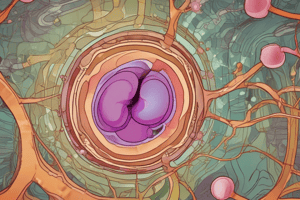Podcast
Questions and Answers
What is the main force driving fluid filtration from the capillary to Bowman's capsule?
What is the main force driving fluid filtration from the capillary to Bowman's capsule?
- Osmotic pressure
- Partial pressure
- Oncotic pressure
- Hydrostatic pressure (correct)
What is the function of the proximal convoluted tubule?
What is the function of the proximal convoluted tubule?
- Filtration of blood
- Storage of urine
- Secretion of waste products
- Reabsorption of water and solutes (correct)
What is the term for the partial pressure of a solute that must be unable to cross the cell membrane?
What is the term for the partial pressure of a solute that must be unable to cross the cell membrane?
- Osmotic pressure (correct)
- Partial pressure
- Oncotic pressure
- Hydrostatic pressure
What is the function of the renal nerve in the renal structure?
What is the function of the renal nerve in the renal structure?
What is the term for the blood vessel that carries blood away from the glomerulus?
What is the term for the blood vessel that carries blood away from the glomerulus?
What is the term for the structure that surrounds the glomerulus?
What is the term for the structure that surrounds the glomerulus?
What is the function of the glomerulus?
What is the function of the glomerulus?
What is the term for the process by which fluid is forced to diffuse from the capillary to Bowman's capsule?
What is the term for the process by which fluid is forced to diffuse from the capillary to Bowman's capsule?
What is the term for the blood vessel that carries blood to the glomerulus?
What is the term for the blood vessel that carries blood to the glomerulus?
What is the term for the tube-like structure that drains urine from the kidney?
What is the term for the tube-like structure that drains urine from the kidney?
Flashcards are hidden until you start studying
Study Notes
Regulation of Urine Production
- Osmoreceptors in the hypothalamus monitor plasma osmolarity
- Renal blood flow is regulated by juxtaglomerular cells
- Response mediators include:
- Anti-diuretic hormone (ADH)
- Sympathetic activation
- Renin-angiotensin-aldosterone system (RAAS)
Anti-Diuretic Hormone (ADH)
- ADH increases water permeability in the distal and collecting ducts, leading to concentrated urine
- ADH causes vasoconstriction, decreasing renal blood flow and increasing urea permeability
- ADH regulates water reabsorption in the collecting duct
Renin-Angiotensin-Aldosterone System (RAAS)
- RAAS regulates blood pressure and electrolyte balance
- Aldosterone reabsorbs Na+ and K+ in the collecting duct
Micturition (Urination)
- Micturition is controlled by both somatic and autonomic nervous systems
- The process involves:
- Contraction of detrusor muscle
- Relaxation of internal and external sphincters
Normal Chemical Composition of Urine
- Urine consists of >95% water
- Minimum constituents per liter of urine
- ADH regulates water reabsorption, affecting urine concentration
Urea Cycle
- Urea is reabsorbed in the collecting tubule in the presence of ADH
- Urea increases in the interstitial space, increasing osmolarity in the renal medulla
- Urine production involves eliminating waste, acid, and nitrogen from the body
Regulation of Renal Water Reabsorption
- Body regulates urine production by monitoring:
- Blood volume
- Plasma osmolarity
- Blood pressure and blood flow
- Blood fluid sensors include:
- Atrial stretch receptors (right atrium)
Renal Structure
- Blood supply: renal artery and vein
- Nerve supply: renal nerve (autonomic nervous system)
- Renal tissue consists of:
- Renal fibrous tissue
- Cortex and medulla
- Renal calyx and pelvis
Nephron
- Glomerulus and Bowman's capsule form the filtering unit
- Tubular nephron reabsorbs water and solutes back to renal tissue and blood
- Each tubular region has different actions on water and solute reabsorption
- Glomerular filtration:
- Fluid in the capillary is forced to diffuse into Bowman's capsule
- Force driving fluid is capillary hydrostatic pressure
- Water, electrolytes, amino acids, glucose, and urea are filtered into Bowman's capsule
Studying That Suits You
Use AI to generate personalized quizzes and flashcards to suit your learning preferences.




